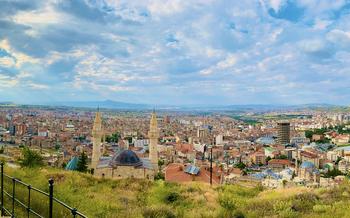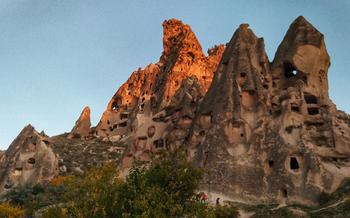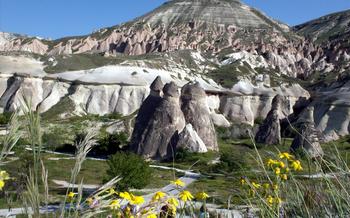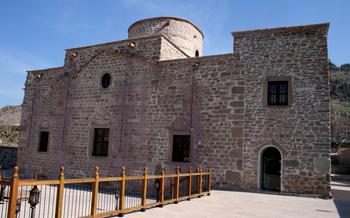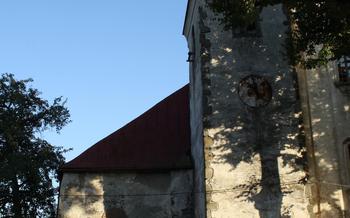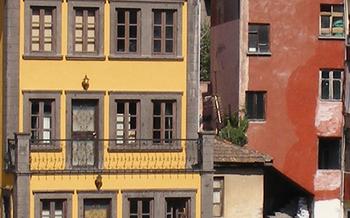
St. John the Baptist Church (Vaftizci Yahya Kilisesi)
- Unveiling the St. John the Baptist Church: A Journey into History
- Exploring the Church's Interior: A Realm of Art and Devotion
- The Baptismal Font: A Symbol of Faith
- The Nave and Apse: A Space for Worship and Contemplation
- The Narthex: A Place of Transition
- The Exterior: A Blend of Architectural Styles
- The Courtyard: A Haven of Tranquility
- The Monastery Complex: A Place of Worship and Community
- The Role of St. John the Baptist in Christianity
- The Church's Place in the History of Christianity
- Tips for Visiting the Church: Making the Most of Your Experience
- Local Customs and Traditions: Unveiling the Cultural Heritage
- Planning Your Trip: Practical Considerations
- Insider Tips: Unveiling a Hidden Gem
Unveiling the St. John the Baptist Church: A Journey into History
Nestled within the heart of Göreme, Turkey, the St. John the Baptist Church stands as a testament to the rich history and cultural significance of the region. With roots dating back to the Byzantine era, the church holds immense historical value, serving as a pilgrimage site for Christians worldwide. Its stunning architecture, intricate frescoes, and enduring resilience make it a must-visit destination for those seeking a glimpse into the past and a deeper understanding of Christianity's origins. As we delve into the story of St. John the Baptist Church, we'll uncover the mysteries that lie within its walls, unraveling its significance as a symbol of faith, resilience, and artistic expression.
Exploring the Church's Interior: A Realm of Art and Devotion
Venturing into the St. John the Baptist Church is like stepping into a sacred realm where art and devotion intertwine. The walls are adorned with captivating frescoes, a testament to the artistry and religious fervor of the Byzantine era. These intricate paintings depict biblical narratives, bringing to life stories from the Old and New Testaments. The vibrant colors and expressive figures create a sense of awe and wonder, inviting visitors to contemplate the profound messages embedded within the artwork.
Beyond their aesthetic beauty, the frescoes hold profound iconography and symbolism. Each scene, each gesture, and each object carries a deeper meaning, revealing the theological beliefs and spiritual aspirations of the time. These visual representations of faith provide a glimpse into the minds and hearts of the early Christians who sought to express their devotion through art.
Preserving these magnificent frescoes is of utmost importance, as they represent a priceless heritage that connects us to the past. Ongoing conservation efforts are dedicated to protecting and restoring these artworks, ensuring that they continue to inspire and captivate generations to come.
The Baptismal Font: A Symbol of Faith
At the heart of St. John the Baptist Church lies a significant symbol of Christian faith: the baptismal font. This sacred vessel holds immense spiritual and historical importance, serving as a witness to countless baptismal ceremonies that have taken place within these hallowed walls.
Unveiling the Significance
The baptismal font in St. John the Baptist Church represents the Christian sacrament of baptism, a rite of initiation and spiritual rebirth. Through the act of baptism, individuals are welcomed into the Christian community, cleansed of their sins, and united with Christ. The font serves as a tangible reminder of this transformative ritual, a symbol of faith and the beginning of a new journey in Christ.
Architectural Details
The baptismal font at St. John the Baptist Church is a remarkable work of craftsmanship, showcasing the artistic skill and devotion of its creators. Carved from a single block of stone, the font displays intricate details and elegant simplicity. Its shape and design reflect the symbolism associated with baptism, inviting contemplation and reflection.
Symbolism and Rituals
The baptismal font is adorned with symbolic motifs that convey profound spiritual meanings. Water, a central element in baptism, is represented through the font's shape and placement. The act of immersion or sprinkling water symbolizes purification, cleansing, and the washing away of sins. The font's position within the church, often near the entrance, emphasizes the importance of baptism as the gateway to the Christian faith.
Historical Context
The baptismal font at St. John the Baptist Church stands as a testament to the enduring legacy of Christianity in Cappadocia. Throughout history, this sacred vessel has witnessed the baptisms of generations of believers, each carrying their hopes, dreams, and faith within its waters. The font serves as a reminder of the continuity of Christian traditions and the enduring power of faith in this ancient land.
The Nave and Apse: A Space for Worship and Contemplation
The nave and apse of St. John the Baptist Church form the central space for worship and contemplation. The nave, the main body of the church, is a spacious and airy chamber, supported by rows of slender columns. Its walls are adorned with a series of vibrant frescoes depicting scenes from the Bible, narrating the life and teachings of Jesus Christ. These frescoes, with their vivid colors and expressive figures, captivate the attention of visitors and invite them to delve deeper into the stories of faith and devotion.
The apse, the semi-circular sanctuary at the eastern end of the nave, holds a special significance. It is here that the altar, the focal point of Christian worship, is located. The apse is often decorated with even more elaborate frescoes, often depicting the Virgin Mary, Jesus Christ, or other saints. The interplay of natural light filtering through the windows, casting a soft glow on the frescoes, creates a serene and awe-inspiring atmosphere within the nave and apse, enhancing the spiritual experience of worshippers and visitors alike.
The Narthex: A Place of Transition
The narthex, the entrance to the church, serves as a welcoming space for worshippers as they transition from the outside world into the sacred realm of the church. This liminal space is adorned with vibrant frescoes and symbolic motifs that offer glimpses into the deeper meanings and teachings of Christianity. The architectural features of the narthex, such as its arches, columns, and intricate carvings, contribute to its unique ambiance and create a sense of awe and reverence. Historically, the narthex played a crucial role in welcoming visitors and preparing them for the spiritual experience that awaited them within the church.
The Exterior: A Blend of Architectural Styles
The exterior of the St. John the Baptist Church showcases a captivating blend of architectural styles that reflects its rich history. Byzantine influences are evident in the intricate stone carvings and decorative elements that adorn the church's facade. These include beautiful stone crosses, geometric patterns, and depictions of saints and biblical scenes. The church's exterior also features unique rock-cut elements, such as niches and chambers, which have been carved into the surrounding rock formations. These rock-cut features create a harmonious integration between the natural and man-made elements of the church, showcasing the ingenuity and skill of the builders. Additionally, the church's exterior is adorned with decorative details such as moldings, cornices, and arches, which add to its overall visual appeal. From the church's exterior, visitors can also enjoy breathtaking panoramic views of the surrounding landscapes, including the picturesque town of Göreme and the unique rock formations that characterize the region.
The Courtyard: A Haven of Tranquility
Amidst the grandeur of St. John the Baptist Church, the courtyard stands as an oasis of serenity and contemplation. Stepping into this tranquil space, visitors are greeted by a sense of peace and tranquility that invites them to pause and reflect. Cypress trees, with their towering presence, cast long shadows that dance across the courtyard, creating a picturesque scene of natural beauty. Lush vegetation, carefully tended to, adds a touch of color and life to the serene surroundings.
Architectural elements, such as graceful arches, elegant columns, and intricate decorative details, adorn the courtyard, enhancing its aesthetic appeal. These features blend harmoniously with the natural surroundings, creating a cohesive and visually pleasing space. In the courtyard, visitors can find respite from the bustle of the church and immerse themselves in a moment of quiet reflection, surrounded by the beauty of nature and the echoes of history.
The Monastery Complex: A Place of Worship and Community
In the vicinity of the St. John the Baptist Church lies a remarkable monastery complex, steeped in history and spiritual significance. This ancient complex, once a haven for monks and a center of religious devotion, offers a glimpse into the monastic life and the vibrant Christian community that flourished in this region.
The monastery complex, constructed in the Byzantine era, comprises various structures arranged around a central courtyard. These include living quarters, refectories, storage spaces, and chapels, all of which speak to the self-sufficient and communal nature of monastic life. Within these walls, monks dedicated themselves to prayer, study, and contemplation, fostering a deep connection with the divine.
The architectural layout of the complex reflects the principles of monasticism, with its emphasis on simplicity, functionality, and communal living. The structures are adorned with intricate carvings and frescoes, showcasing the artistic prowess of the Byzantine period. Visitors can wander through the courtyards, imagining the daily rituals and spiritual practices that once took place within these hallowed grounds.
The monastery complex serves as a testament to the enduring legacy of monasticism in Cappadocia and its profound impact on the region's religious and cultural heritage. It invites visitors to step back in time, immerse themselves in the atmosphere of devotion and spirituality, and gain a deeper understanding of the rich tapestry of Christian history in this fascinating part of the world.
The Role of St. John the Baptist in Christianity
In the realm of Christianity, St. John the Baptist holds a significant position as a prophet and forerunner of Jesus Christ. His teachings and example have left an indelible mark on the faith, emphasizing the virtues of humility and repentance. As the patron saint of Göreme, St. John the Baptist occupies a special place in the town's religious and cultural heritage. His feast day, celebrated annually, draws pilgrims and visitors from near and far to honor his legacy and seek spiritual guidance. Through his teachings and example, St. John the Baptist continues to inspire believers, reminding them of the importance of humility, repentance, and the pursuit of a deeper connection with the divine.
The Church's Place in the History of Christianity
St. John the Baptist Church holds a significant place in the history of Christianity, serving as an early Christian center in Cappadocia. It played a pivotal role in the spread of Christianity throughout the region, becoming a symbol of the faith's deep roots and enduring legacy. The church stands as a testament to the rich Byzantine heritage of the area, showcasing its architectural and artistic contributions to the development of Christian art and architecture. Over the centuries, the church has attracted pilgrims from far and wide, seeking spiritual inspiration and a connection to the early days of Christianity. It represents the religious diversity that once characterized the region, coexisting peacefully with other faiths, symbolizing the harmonious blend of cultures and beliefs that shaped Cappadocia's unique identity.
Tips for Visiting the Church: Making the Most of Your Experience
To fully immerse yourself in the experience of visiting St. John the Baptist Church, consider the following recommendations:
-
Recommended time to visit: Aim for early morning or late afternoon to avoid the midday heat and crowds. The golden hues of sunrise and sunset also create a magical ambiance for photography.
-
Dress code and etiquette: Respect the sanctity of the church by dressing modestly and behaving respectfully. Silence your mobile phone and avoid loud conversations to maintain a serene atmosphere.
-
Photography guidelines: While photography is permitted, flash photography is strictly prohibited to preserve the delicate frescoes. Tripods may also be restricted, so inquire beforehand.
-
Guided tours: Enhance your visit by joining a guided tour led by knowledgeable local experts. These tours offer insightful narratives about the church's history, architecture, and religious significance, bringing the site to life.
Local Customs and Traditions: Unveiling the Cultural Heritage
Cappadocia is renowned for its warm and welcoming people, who uphold their cultural traditions and hospitality with pride. Visitors to St. John the Baptist Church and the surrounding region will be embraced by the locals' genuine warmth and friendliness. Indulge in the delectable flavors of Cappadocian cuisine by sampling local dishes that showcase the region's culinary heritage. From hearty kebabs to savory pastries, there's a culinary adventure waiting for every palate. Take home a piece of Cappadocia by purchasing local handicrafts, such as intricately patterned pottery, vibrant carpets, or exquisite jewelry. These souvenirs will serve as lasting mementos of your journey and support the local artisans who create them. Remember to respect local customs and traditions to ensure a positive and meaningful interaction with the Cappadocian community.
Planning Your Trip: Practical Considerations
Before embarking on your journey to visit the St. John the Baptist Church, it's essential to consider practical aspects to ensure a smooth and enjoyable experience. For accommodation, Göreme and nearby towns offer a range of options catering to different budgets and preferences. From cozy guesthouses to luxurious cave hotels, there's something for every traveler.
Transportation to Göreme is convenient, with options including buses, trains, and rental cars. Buses provide a budget-friendly and reliable mode of transport, while trains offer a scenic journey through the picturesque Turkish countryside. If you prefer the flexibility of exploring at your own pace, renting a car is an excellent choice, allowing you to discover the region's hidden gems at your leisure.
To make the most of your time in Göreme, consider participating in guided tours or activities that combine a visit to the church with other captivating attractions in the area. Hot air balloon rides at sunrise offer a breathtaking perspective of the unique rock formations and fairy chimneys that characterize Cappadocia. Additionally, guided hikes or ATV tours provide adventurous ways to explore the region's stunning landscapes.
Budgeting for your trip is crucial to ensure a stress-free experience. Entrance fees to the church are minimal, and there are various dining options in Göreme, ranging from budget-friendly local eateries to upscale restaurants serving traditional Turkish cuisine. Souvenirs and handicrafts can be purchased at local shops, supporting the local economy and taking home a piece of Cappadocian culture.
Insider Tips: Unveiling a Hidden Gem
Secret Viewpoint: Discover a hidden viewpoint tucked away near the church that offers breathtaking panoramic vistas. Capture stunning photographs of the church nestled amidst the unique rock formations and valleys of Göreme.
Off-Season Charm: Escape the crowds and experience the serenity of the church during the shoulder or off-season. Immerse yourself in the tranquil atmosphere and enjoy a more personal and intimate encounter with its history and beauty.
Local Guides: Seek out local guides who are passionate about sharing the stories and significance of the church. Engage with their personal anecdotes and gain a deeper understanding of its heritage and cultural importance.
Photography Tips: Maximize your photography experience with insider tips for capturing the essence of the church. Learn the best angles, lighting conditions, and techniques to capture stunning shots of its intricate frescoes, architectural details, and panoramic vistas.
